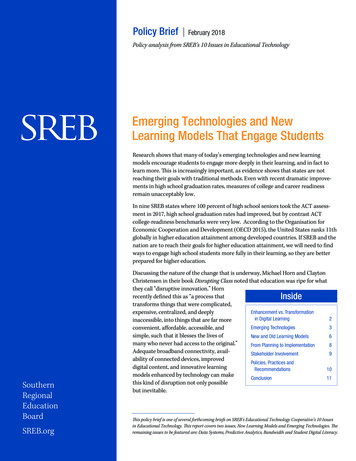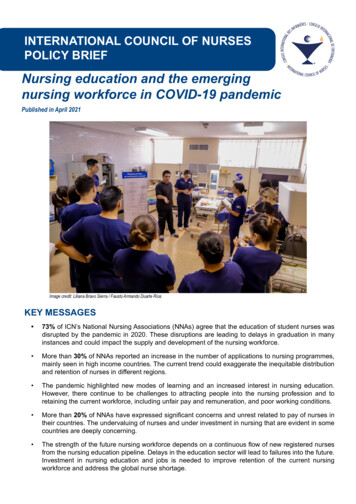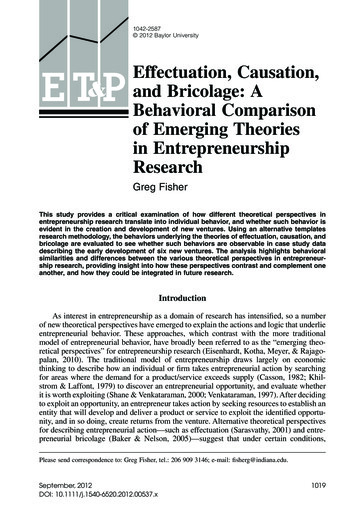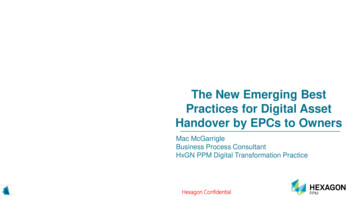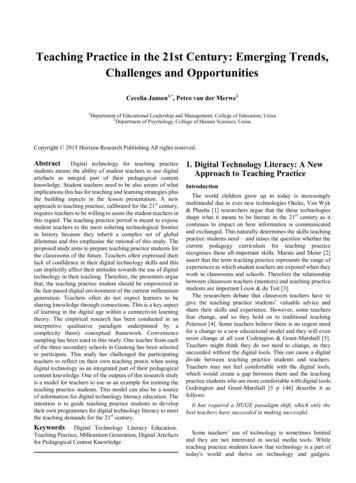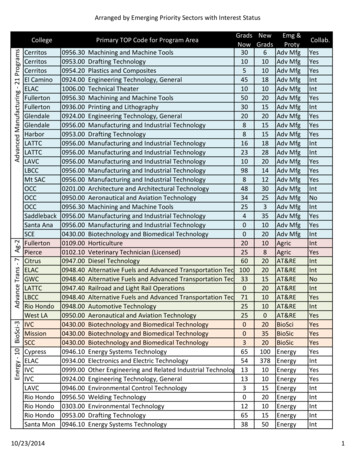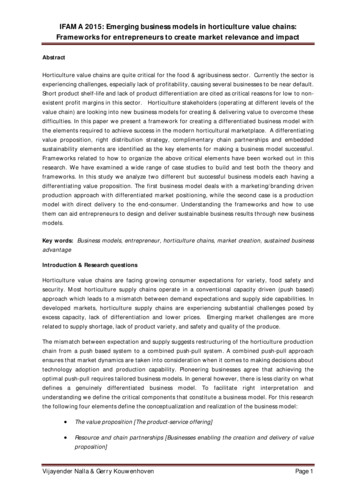
Transcription
IFAMA 2015: Emerging business models in horticulture value chains:Frameworks for entrepreneurs to create market relevance and impactAbstractHorticulture value chains are quite critical for the food & agribusiness sector. Currently the sector isexperiencing challenges, especially lack of profitability, causing several businesses to be near default.Short product shelf-life and lack of product differentiation are cited as critical reasons for low to nonexistent profit margins in this sector. Horticulture stakeholders (operating at different levels of thevalue chain) are looking into new business models for creating & delivering value to overcome thesedifficulties. In this paper we present a framework for creating a differentiated business model withthe elements required to achieve success in the modern horticultural marketplace. A differentiatingvalue proposition, right distribution strategy, complimentary chain partnerships and embeddedsustainability elements are identified as the key elements for making a business model successful.Frameworks related to how to organize the above critical elements have been worked out in thisresearch. We have examined a wide range of case studies to build and test both the theory andframeworks. In this study we analyze two different but successful business models each having adifferentiating value proposition. The first business model deals with a marketing/branding drivenproduction approach with differentiated market positioning, while the second case is a productionmodel with direct delivery to the end-consumer. Understanding the frameworks and how to usethem can aid entrepreneurs to design and deliver sustainable business results through new businessmodels.Key words: Business models, entrepreneur, horticulture chains, market creation, sustained businessadvantageIntroduction & Research questionsHorticulture value chains are facing growing consumer expectations for variety, food safety andsecurity. Most horticulture supply chains operate in a conventional capacity driven (push based)approach which leads to a mismatch between demand expectations and supply side capabilities. Indeveloped markets, horticulture supply chains are experiencing substantial challenges posed byexcess capacity, lack of differentiation and lower prices. Emerging market challenges are morerelated to supply shortage, lack of product variety, and safety and quality of the produce.The mismatch between expectation and supply suggests restructuring of the horticulture productionchain from a push based system to a combined push-pull system. A combined push-pull approachensures that market dynamics are taken into consideration when it comes to making decisions abouttechnology adoption and production capability. Pioneering businesses agree that achieving theoptimal push-pull requires tailored business models. In general however, there is less clarity on whatdefines a genuinely differentiated business model. To facilitate right interpretation andunderstanding we define the critical components that constitute a business model. For this researchthe following four elements define the conceptualization and realization of the business model: The value proposition [The product-service offering] Resource and chain partnerships [Businesses enabling the creation and delivery of valueproposition]Vijayender Nalla & Gerry KouwenhovenPage 1
IFAMA 2015: Emerging business models in horticulture value chains:Frameworks for entrepreneurs to create market relevance and impact The value delivery [ The process of exchanging value and finances] Sustainability components [addressing the effects on people, society and the environmentwhile pursuing the profit component]By fine-tuning each of the above elements, a different business model can be created. But how toturn the theory into practice remains a critical question. The entrepreneur seeking to develop a newbusiness model must answer four important questions.1. How can an entrepreneur configure a differentiated value proposition?2. How can an entrepreneur work out his distribution strategy?3. How can an entrepreneur realize complimentary chain partnerships that would enablehim to deliver the value proposition?4. How should the entrepreneur approach sustainability in the context of his new businessmodel?Research methodTo address these questions we take support from the published literature and from two real life casestudies. We will also make use of extensive interviews and discussions with entrepreneurs andexperts who are pioneering business model innovators.Literature research:Research relevant to this study focuses on demand-supply dynamics and quantifies the opportunitiesand constraints within horticulture value chains. Additional relevant literature deals with theeconomics of technology development and how these technologies overcome constraints imposedby the current demand-supply dynamics. Thirdly, we will be looking at the literature that deals withbusiness model innovation in general and specifically within the horticulture sector. Combininginsights from these three areas and applying them to the four practical business models enables us todefine the conditions and parameters under which one business model performs better thananother.Ahmed et al (2011) studies the competitive dynamics within fruit and vegetable value chains inemerging markets and brings out insights related to work force development initiatives andestablishment of connections with developed markets fruit and vegetable value chains. Despommier(2010) and Oskam et. al (2013) provide a good overview of high-tech production systems.Amit & Zott (2001, 2012) suggest business model innovation as a way to create and extract value,especially in times of economic change. Osterwalder (2010) defines a business model through acanvas that is now one of the popular tools for businesses to structure and present their operationaland strategic components for creating and delivering value. Nidumolu et. al (2009) in their HarvardBusiness Review article have dealt extensively with how sustainability is, and will continue to be, akey driver of innovation.Without a business model perspective, a company is a non focused participant in a dizzying array ofnetworks and passive entanglements. Adopting the business model perspective can help executivesVijayender Nalla & Gerry KouwenhovenPage 2
IFAMA 2015: Emerging business models in horticulture value chains:Frameworks for entrepreneurs to create market relevance and impactpurposefully structure the activity systems of their company. This study contributes by defininginnovative business model possibilities in horticulture and provides a framework on “how” to arriveat the right business model. While the Osterwalder (2010) Canvas Business model is very helpful inexplaining an operational or worked-out business model it does not provide a framework on “how”to come to the right business model. The “how” element needs to take the sector specific dynamicsof demand, supply and competition into account to choose the right business model. Once the rightbusiness is worked out the Osterwalder (2010) model can be quite helpful as a check. In this study,horticulture specific “how” elements addressing the creation of value proposition, creation ofcollaborative partnerships, and value delivery are worked out.Analysis and the development of the frameworkLiterature review, expert interviews and successful cases with innovative business models suggestthat a successful business model need at least 4 complimentary components. Differentiated andcompetitive value proposition is the first critical component, while a well worked out distributionstrategy, complimentary chain partnerships and embedded sustainability elements are the otherthree components. These 4 components in the context of the differentiated business model isindicated in Figure 1 inpartnershipsFigure 1: Business model componentsEach of the 4 components indicated in the above figure will be addressed in detail using frameworksto guide how these components are worked out in the context of two case studies. Before weprogress further with the development of the frameworks, we introduce the two case studies.Case study 1: Looije TomatenLooije is a family company in the Netherlands that was set up in 1946 by J.M. Looije, the father of thepresent-day director Jos Looije. The company started out growing a range of vegetables. The oldestson, Jos Looije, joined the company in the 1970s, which is when the company started to specialize inVijayender Nalla & Gerry KouwenhovenPage 3
IFAMA 2015: Emerging business models in horticulture value chains:Frameworks for entrepreneurs to create market relevance and impactgrowing tomatoes. In 1992 they further specialized to growing cherry tomatoes and in 2000 theyadded vine cherry tomatoes to their product range. Up until 2003 they had sold their produce throughauction houses, but after they started selling direct. It was in 2005 that they decided to launch aspecialized brand of tomatoes called Honingtomaten .Case study 2: Lufa FarmsLufa Farms, based in Montreal (Canada), is a commercial agricultural company that is pioneering aviable and sustainable model for city rooftop farms. Without using chemical pesticides, herbicides orfungicides, the company's greenhouses produce more than 100 tons of vegetables the year round. Inaddition to their own production, they also procure from local organic produce growers to enable acomplete food assortment consumers can customize and order on-line and have directly delivered tothem. Lufa Farms distributes more than 3,000 baskets of produce per week through a network ofpick-up points in and around Montreal. Lufa Farms customers choose their products from an onlinegrocery store which allows them to select exactly what goes into their baskets.In the next section we suggest an approach for developing a competitive value proposition.1. Competitive value proposition aligning specific demand-supply dynamicsA value proposition is generally made up of one or more “differentiating attributes” that a sizeablesegment of customer1 is able and willing-to-pay for. The differentiating attributes could be directproduct attributes, service attributes or a combination thereof. Examples of product attributes in thecontext of horticulture are freshness, variety, health impact, consistency, availability, affordabilityetc., while attributes such as convenience and customization are service attributes. A clear andcompetitive value proposition is designed by using one or more differentiating attributes. Using datarelated to existing market offerings, a business can identify and develop a value proposition toidentify and develop an underserved market. This is market innovation, the process of defining andserving combinations of new customer segments and new product attributes.In this research, we offer the following tool to enable an entrepreneur to systematically work-out acompetitive value proposition. The greater the level of insight and intuition in using the tool, themore differentiating the value proposition can be.1We consistently try to use customer segments to cover industrial clients and the end-consumers. A customersegment is a sizeable group (in its current form or growth form) that is able to offer a realistic business caseVijayender Nalla & Gerry KouwenhovenPage 4
IFAMA 2015: Emerging business models in horticulture value chains:Frameworks for entrepreneurs to create market relevance and impactCustomersegment distributionchannelcombinationAA1 cy .AvailabilityConvenienceCustomization .BA3 1511011311242121232222111221B2B3 . .Figure 2: Value proposition ToolProduct and service attributes are the key starting points in creating the value proposition. Theabove table lists some common product attributes but is in no way exhaustive. In fact the innovativeentrepreneur identifies and creates new attributes as a way to differentiate and create a competitivevalue proposition. In that sense the tool is open ended and can accommodate whatever attributesan entrepreneur believes would be valued and paid for.Next the tool defines the consumer segment in the context of a distribution channel. The reason forthis is that, in the context of food, a consumer nearly always makes use of several channels andhis/her behavior at each can be quite different. Gajanan & Basuroy (2007) describes how consumersperceive and respond to sellers, their products, and the environment in which they are sold and viceversa. For example a consumer at a retail supermarket exhibits higher price sensitivity than at onthe-go channels (such as train stations). Hence to be able to create a more pragmatic and executablevalue proposition, the tool considers both the consumer profile & the distribution channel.Once these two elements are worked out appropriately, the consumer segment preference for eachof the attributes can be marked on a scale 1-5 (and if any attribute is not important/ relevant for aspecific segment then that particular attribute can be ignored). This is represented by the column A1in the tool. Subsequently, the current ability of the most effectively performing player (we call thisVijayender Nalla & Gerry KouwenhovenPage 5
IFAMA 2015: Emerging business models in horticulture value chains:Frameworks for entrepreneurs to create market relevance and impactprocess benchmarking the competition) can be mapped, again using the same scale 1-5. Thisbenchmarking is presented in column A2 and the difference (A2-A1) gives an indication of thepotential underserved demand. If an entrepreneur can address this gap through already existingcapabilities, or through investment, then there
innovative business model possibilities in horticulture and provides a framework on “how” to arrive at the right business model. While the Osterwalder (2010) Canvas Business model is very helpful in explaining an operational or worked-out business model it does not provide a framework on “how” to come to the right business model. The “how” element needs to take the sector specific dynamics
